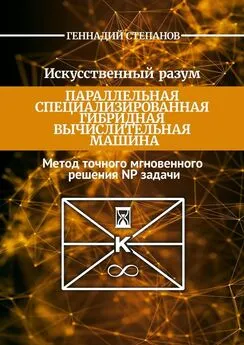Марина Грабарь - Английский для военных/Military English. Метод кейсов/Cases. Решения, ответы, словарь, глоссарий
- Название:Английский для военных/Military English. Метод кейсов/Cases. Решения, ответы, словарь, глоссарий
- Автор:
- Жанр:
- Издательство:неизвестно
- Год:неизвестен
- ISBN:9785449881755
- Рейтинг:
- Избранное:Добавить в избранное
-
Отзывы:
-
Ваша оценка:
Марина Грабарь - Английский для военных/Military English. Метод кейсов/Cases. Решения, ответы, словарь, глоссарий краткое содержание
Английский для военных/Military English. Метод кейсов/Cases. Решения, ответы, словарь, глоссарий - читать онлайн бесплатно ознакомительный отрывок
Интервал:
Закладка:
Two intelligenceissues complicate planning for the WMD-E mission.
– First, intelligence gapswill likely mean that critical facilities rumored or reported to exist cannot be located.
– Second, as previously noted, many weapons – particularly CWs – are likely to have been dispersed to numerous tactical operational sitesthat cannot be identified in advance and are not included in estimates of a country’s WMD infrastructure.
3. Parametric Analyses of WMD-E Force Requirements
We estimated WMD-E forces under different scenario assumptions that varied the following parameters:
1 • the number and sizes of WMD sitesfor WMD-E operations
2• force requirementsdictated by the operational environment
3• the ratioof supporting forcesto mission forces.
– Sensitivity of Force Requirements to Operational Environments and Support Ratios The ground forcerequirements are presented as a function of the operating environment (Uncertain or Hostile, and level of threat) and the assumed support ratio (low, midlevel, or high), broken out by the different elements of the WMD-E mission force.
Ground force requirements for WMD-E operations in our illustrative DPRK case are presented in Figure 1.2.
Estimated forcesneeded for WMD-E operations could be…
5. Observations on the DPRK Case Study
As described in this case study, WMD-E operationsin the wake ofa collapse ofthe DPRK.
– What are the assumptionsdriving results?
– What does Your results suggest?
Welcome To The DPRK (Video)
https://drive.google.com/file/d/1YRUncnqAJ7YDe_N8UeRdpGOwFQZq KDwy/view? usp=sh aring
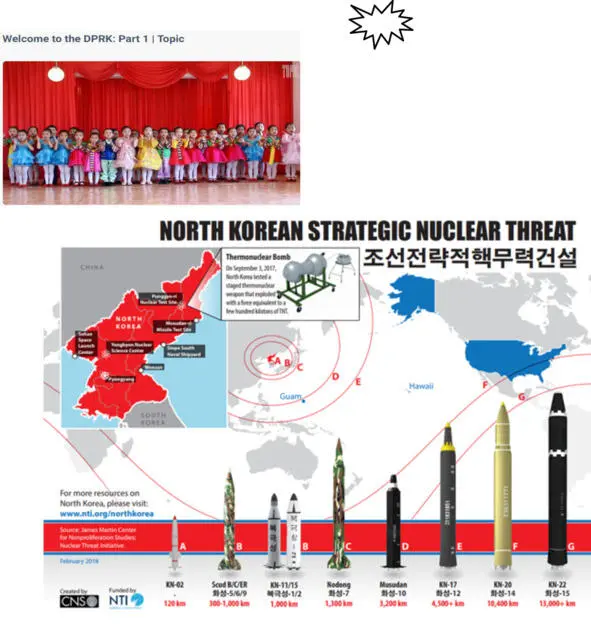

Solutions
Question 1
1. Campaign Design
A WMD-E campaign would balance key objectives and missions; strategic, operational, and tactical risks; and the joint forces needed to interdict, attack, and/or eliminate nuclear forces and sites quickly enough to minimize the risks of proliferation or use.
The WMD-E maneuver scheme could adopt one or a combination of the following approaches:
– a northward movement of U.S. ground forces and RoK allies across the DMZ along one or more axes of advance; (2) the introduction of forces from the sea on one or both coasts to reduce the distances that ground forces need to advance to reach priority nuclear WMD sites; and/or (3) air maneuver operations involving airborne or air assault forces directly assaulting the highest-priority sites, with other ground forces maneuvering to meet up with these forces, and joint SOF, air, and naval forces supporting.
Answer
Each of the three approaches listed above involves associated benefits and risks.
For example, a northward advance would establish secure areas for elimination operations but could also be quite slow, and such an advance could well face the greatest concentration of opposing DPRK forces – hence, the highest casualties, especially if those DPRK forces had the ability and will to fight.
The approach based on operationally maneuvering from the seacould also face stiff opposition, and it would introduce some logistical challenges, but it would also shorten the distances – and potentially the time – that maneuver and WMD-E TFs have to advance to key DPRK nuclear and missile sites in the north.

Finally,
Figure 1.1
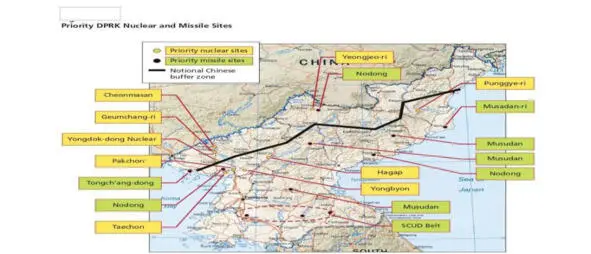
might be the fastest way to seize DPRK nuclear sites until the WMD-E TFs arrive, but this approach could leave the assault forces exposed and isolated. Trade-offs between risks and timelines also exist:
Some risks might be mitigated, for example, by conducting heliborne assault opera-tions against a site only when heavier ground maneuver forces are closing on that site so that assaulting forces can be quickly reinforced.
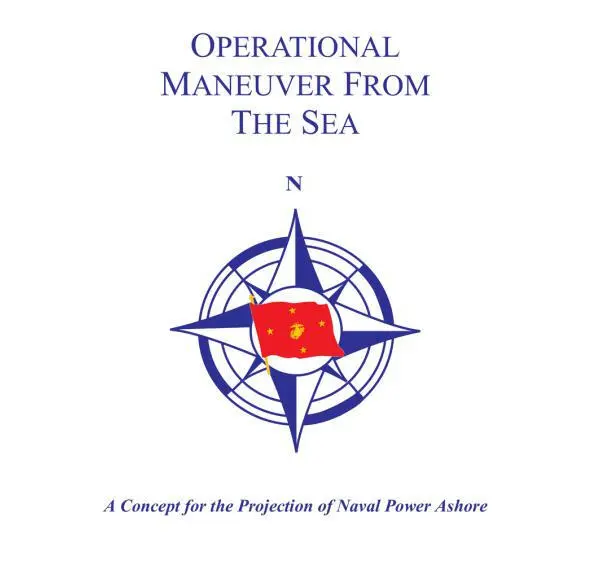
Question 2
2. Intelligence Requirements.
The quality and reliabilityof U.S. intelligence will be critical in winnowing the number of sites to be initially assaulted, seized, and secured down to those that will best reduce the risk of WMD being leaked or employed.
For example, poorintelligencecan result in forces being sent to seize and secure sites bereft of WMD
Very good intelligencecould, in theory, reduce the number of sites requiring coverage, support the efficient allocation of limited resources, and reduce risk. (In practice, however, North Korean efforts to hide weapons and disguise sites may significantly diminish the effectiveness of U.S. and allied intelligence.)
Twointelligenceissues complicate planning for the WMD-E mission.
– First, intelligence gapswill likely mean that critical facilities rumored or reported to exist cannot be located.
– Second, as previously noted, many weapons – particularly CWs – are likely to have been dispersed tonumerous tacticaloperationalsitesthat cannot be identified in advance and are not included in estimates of a country’s WMD infrastructure.
Answer
For the WMD-E missionin North Korea, even in a DPRK collapse scenario, forces searching for WMD will not know what type of resistancethey might encounter. TFs should consist, therefore, of both WMD specialists and general-purpose forces that are adequate for the potential threatand tactical situation. This could be a significant consideration given the nature of North Korea’s armed forcesand the degree to which its populationis armed and indoctrinated to fear and distrust U.S. and RoK forces.

Figure 1.1
Question 3
3. Parametric Analyses of WMD-E Force Requirements
We estimated WMD-E forces under different scenario assumptions that varied the following parameters:
1 • the number and sizes of WMD sitesfor WMD-E operations
2• force requirementsdictated by the operational environment
3• the ratioof supporting forcesto mission forces.
Answer
1.The number and sizes of WMD sites for WMD-E operations.
For WMD- E operations, we assess that the nuclear sitesassociated with fuel enrichingand processingwould be the next priorities, along with nuclear weapon manufacturing, testing, and storage sites. For our base case, we selected 12 battalionTFs as the minimum force that a commander should be allocated to seize, secure, search, and eliminate the priority nuclear sites. We note that 12 WMD-E TFs is a planning factor only.
For example, if intelligence suggeststhat the highest-priority nuclear activitiesshould be conducted at nine sites, as shown in Table 1.1,
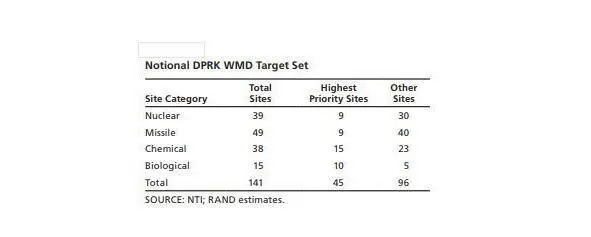
Table 1.1
then a minimum of tenbattalion-sized TFs should be assigned to these nine sites. In the course of an operation, the U.S. commander might use these 12 WMD-E TFs
differently. For example, recall that in Figure 4.1 four of the priority nuclear sites and two of
the priority missile sites were located approximately 50 km from the Chinese border.
2. Operational environment and force requirements.
– WMD-E (Uncertain): This environment features a low threat level – consistent with the collapse of the DPRK regime and complete disintegration of the military. This might occur if a power struggle within the Kim regime resulted in open fighting that pushes an already dangerously unstable economy and society into chaos and collapse.
– WMD-E (Uncertain/High Threat)
This environment features a greater threat level – consistent with the collapse of the DPRK regime and the higher echelons of its military. As in the Uncertain case above, this environment might arise from a violent conflict within the DPRK’s leadership.
– WMD-E (Hostile):the basis of the Hostile environment is that U.S. entry into North Korea would be met with hostility by former regime and military members and perhaps many in the general public. In the internal collapse case, entering North Korea might be predicated on relieving a massive humanitarian catastrophe and controlling refugee flows – with securing WMD being necessary to prevent their transfer.
– WMD-E (Hostile/High Threat): This environment features the collapse of the DPRK regime but with the military remaining intact to a large extent. This environment might result from an internal regime struggle and collapse as before. But, in this case, the military manages to hold itself together.
We used these four environmentdescriptions to calculate the forcesrequired for the missions shown in Table 1.2.
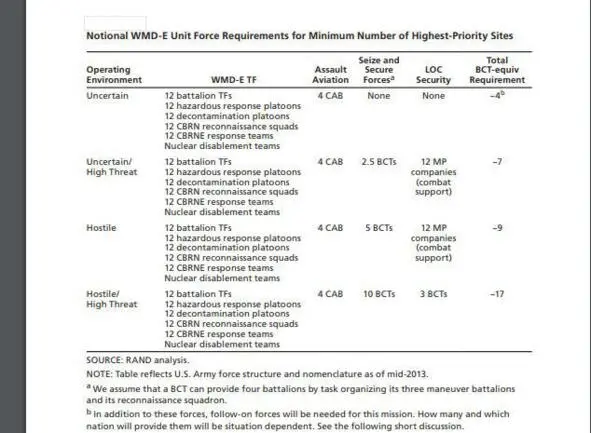
In each case, we assessed that a battalion-sized WMD-E TF was the minimum size needed to provide sufficient organic security at each site and that – at a minimum—12 such TFs would be provided (ten for priority nuclear sites, with two in reserve for pop-up targets).
3. Ratio of supporting forces to mission forces.
For operations in the DPRK,such support would most likely be provided by military units:
– 1.5:1: This represents the lower-end bound of OIF and OEF support for Army operations.
– 2.5:1: We use this ratio for our baseline. It represents the midlevel support ratios experienced in OIF and OEF.
– 3.5:1: This represents the high-end bound of OIF and OEF support.
Читать дальшеИнтервал:
Закладка:








